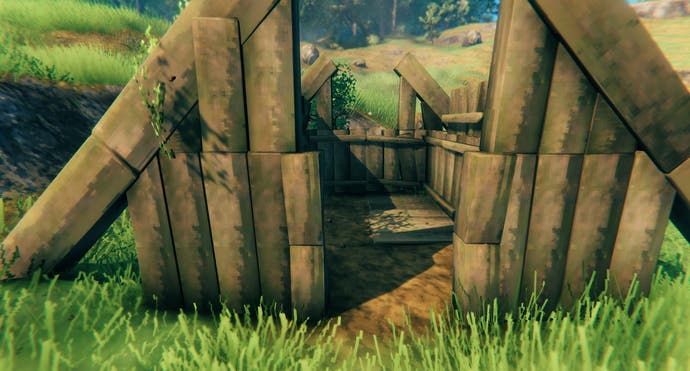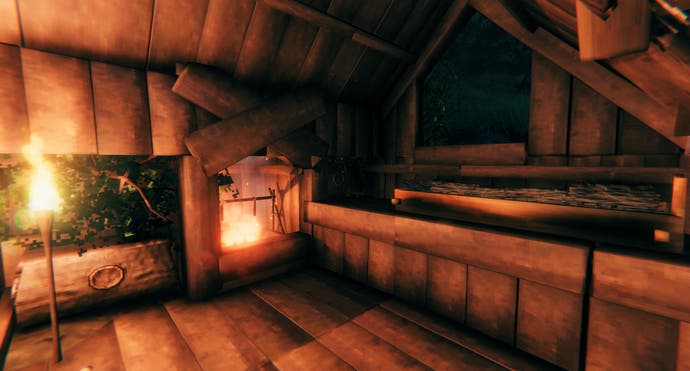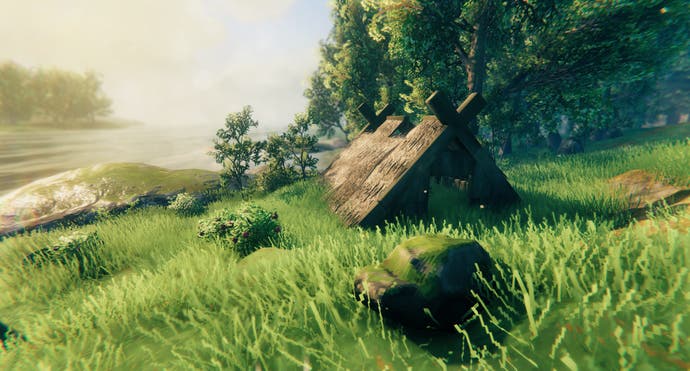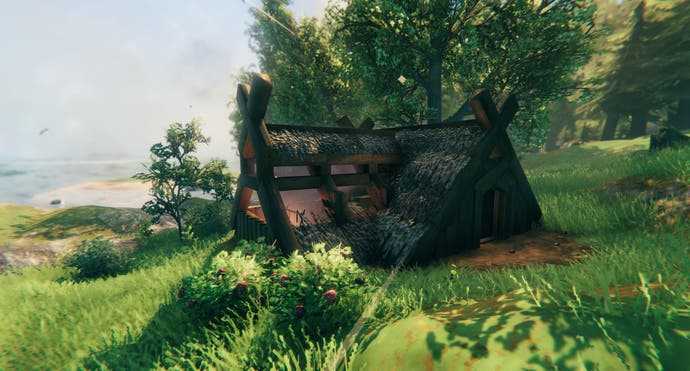Valheim's strengths lie in cosiness, co-operation and small huts
Million dollar beech house.
"Alright warrior," Valheim's raven narrator Hugin told me when I first booted up the game. "Odin's counting on you to slay a bunch of horrible creatures then ascend to Valhalla. It's a perilous journey and you'll need to arm yourself properly to defeat the Forsaken. Are you up for the task?"
"Sure, sure," I said in reply. "But those small huts over there look kinda cute."
If you hadn't yet guessed, I've spent most of my time in Valheim simply building and renovating small cabins. The survival game is split into several biomes, each with its own unique enemies and materials, but it took me at least 15 hours to leave the first - and I've once again found myself constructing tiny homes in the second. Whenever I stumble across ruins I feel obligated to fix them up, like some sort of Viking real estate show. I'm calling it Homes Under Thor's Hammer.
I almost began to feel guilty for delaying exploration to satisfy my building obsession, until I realised Valheim actively encourages this style of play. Travel is necessary to acquire new resources - but with mob raids and danger at night, this requires the creation of multiple outposts. The ruined buildings scattered through the environment are also tempting for a player seeking to gain a foothold in a new area. Yet beyond this, I think Valheim just does cosiness well. I've seen images of massive castles, fortresses and even Millenium Falcons shared on Reddit, and while these are certainly impressive, I still prefer my warm and snuggly little sheds.




In some ways, I think this feeling of cosiness is down to Valheim's art style: that blend of low-resolution textures and modern lighting creates lovely fireside glows, while the dazzling sunsets can make your hut look rather photogenic. Small buildings nestled in a vast wilderness seem to work particularly well with this style. But cosiness is also encouraged through the building system, with most components made of natural wood, and surprisingly realistic limits on how you can build. You can't just Fortnite your way up to the world tree: Valheim's structures require support, and there's a limit to how high you can go. The building pieces themselves provide inspiration, with angled roofs and slanted beams encouraging you to think outside the 2x2 box. Not to mention that ventilated roofed chimneys are a requirement - unless you want your fire to go out in the rain, or to choke to death on smoke.

In the early biomes, at least, Valheim also creates a persistent sense of danger without making death too devastating. Some survival games demand a constant search for food, but in Valheim lack of sustenance isn't lethal, allowing more time for uninterrupted building. Since you can collect all your items from your gravestone, this allows for some level of relaxation and creativity - while your buildings still feel meaningful as a refuge from enemies and storms. Unusually, it's a survival game that lets you pace yourself and progress to more brutal biomes when ready. I think it's from this balance of creativity and danger that Valheim allows space for that cosy, hunkered-down-in-a-hut feeling.
Thinking more broadly, perhaps it comes as little surprise that Valheim is so good at cosiness - it's a game about Vikings taming the wilderness, made by a Swedish studio. Many Scandinavian countries have specific terms to describe cosiness (the Old Norwegian/Danish word "hygge" gained so much attention in 2016 it was picked as a finalist for Oxford Dictionaries' word of the year), and the Swedish have a sort-of-version of this called "mys".
Hygge ended up becoming a bit of a marketing buzz word in the US and UK (and I'm therefore hesitant to use it too liberally), yet I still think Scandinavian concepts of cosiness can be applied to Valheim. It doesn't have a direct English translation but hygge is roughly defined as "creating a warm atmosphere and enjoying the good things in life with good people" (as Visit Denmark describes it). It can be anything from lighting candles to enjoying warm food: creating moments of light to make the winter months enjoyable. Often it's about treasuring even simple tasks, and if you've tried to gather materials or cook in Valheim, you'll know the game has plenty of those.


More importantly, hygge is about sharing that sense of comfort with friends. Maybe this is why Valheim, with its emphasis on small-scale co-operation on servers of up to 10 players, has appealed to so many during the cold winter months, when people are searching for ways to get closer to friends. Valheim's about battling monsters and venturing into the unknown, but at the end of each day you return to a place of security and warmth - a place you've created together. Well, unless you've all gotten lost in the Black Forest.


